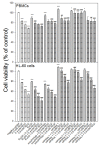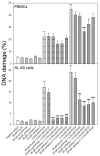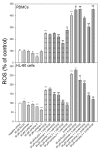Antioxidant Activity of Ruthenium Cyclopentadienyl Complexes Bearing Succinimidato and Phthalimidato Ligands
- PMID: 35566156
- PMCID: PMC9101797
- DOI: 10.3390/molecules27092803
Antioxidant Activity of Ruthenium Cyclopentadienyl Complexes Bearing Succinimidato and Phthalimidato Ligands
Abstract
In these studies, we investigated the antioxidant activity of three ruthenium cyclopentadienyl complexes bearing different imidato ligands: (η5-cyclopentadienyl)Ru(CO)2-N-methoxysuccinimidato (1), (η5-cyclopentadienyl)Ru(CO)2-N-ethoxysuccinimidato (2), and (η5-cyclopentadienyl)Ru(CO)2-N-phthalimidato (3). We studied the effects of ruthenium complexes 1-3 at a low concentration of 50 µM on the viability and the cell cycle of peripheral blood mononuclear cells (PBMCs) and HL-60 leukemic cells exposed to oxidative stress induced by hydrogen peroxide (H2O2). Moreover, we examined the influence of these complexes on DNA oxidative damage, the level of reactive oxygen species (ROS), and superoxide dismutase (SOD) activity. We have observed that ruthenium complexes 1-3 increase the viability of both normal and cancer cells decreased by H2O2 and also alter the HL-60 cell cycle arrested by H2O2 in the sub-G1 phase. In addition, we have shown that ruthenium complexes reduce the levels of ROS and oxidative DNA damage in both cell types. They also restore SOD activity reduced by H2O2. Our results indicate that ruthenium complexes 1-3 bearing succinimidato and phthalimidato ligands have antioxidant activity without cytotoxic effect at low concentrations. For this reason, the ruthenium complexes studied by us should be considered interesting molecules with clinical potential that require further detailed research.
Keywords: DNA oxidative damage; ROS; SOD activity; cell cycle; hydrogen peroxide; phthalimide; ruthenium metallocarbonyl complexes; succinimide.
Conflict of interest statement
All authors declare that they have no conflicts of interest.
Figures





Similar articles
-
Piano-stool ruthenium(II) complexes with maleimide and phosphine or phosphite ligands: synthesis and activity against normal and cancer cells.Dalton Trans. 2023 Mar 28;52(13):4237-4250. doi: 10.1039/d2dt04083b. Dalton Trans. 2023. PMID: 36897334
-
Half-Sandwich Iridium(III) and Ruthenium(II) Complexes Containing P^P-Chelating Ligands: A New Class of Potent Anticancer Agents with Unusual Redox Features.Inorg Chem. 2018 Feb 19;57(4):1705-1716. doi: 10.1021/acs.inorgchem.7b01959. Epub 2018 Feb 5. Inorg Chem. 2018. PMID: 29400963
-
Novel "ruthenium cyclopentadienyl"-peptide conjugate complexes against human FGFR(+) breast cancer.Dalton Trans. 2020 May 14;49(18):5974-5987. doi: 10.1039/d0dt00955e. Epub 2020 Apr 21. Dalton Trans. 2020. PMID: 32314752
-
Detailed account on activation mechanisms of ruthenium coordination complexes and their role as antineoplastic agents.Eur J Med Chem. 2018 Apr 25;150:419-445. doi: 10.1016/j.ejmech.2018.03.015. Epub 2018 Mar 7. Eur J Med Chem. 2018. PMID: 29547831 Review.
-
Synthesis, Biological Activity and Medicinal Applications of Ruthenium Complexes Containing Carbohydrate Ligands.Curr Med Chem. 2019;26(35):6412-6437. doi: 10.2174/0929867326666190124124350. Curr Med Chem. 2019. PMID: 30678616 Review.
Cited by
-
Complexes of Ruthenium(II) as Promising Dual-Active Agents against Cancer and Viral Infections.Pharmaceuticals (Basel). 2023 Dec 15;16(12):1729. doi: 10.3390/ph16121729. Pharmaceuticals (Basel). 2023. PMID: 38139855 Free PMC article. Review.
-
Carbon monoxide refines ovarian structure changes and attenuates oxidative stress via modulating of heme oxygenase system in a rat model of polycystic ovary syndrome: An experimental study.Int J Reprod Biomed. 2024 Oct 14;22(8):627-638. doi: 10.18502/ijrm.v22i8.17231. eCollection 2024 Aug. Int J Reprod Biomed. 2024. PMID: 39494120 Free PMC article.
References
-
- Kacsir I., Sipos A., Ujlaki G., Buglyó P., Somsák L., Bai P., Bokor É. Ruthenium Half-Sandwich Type Complexes with Bidentate Monosaccharide Ligands Show Antineoplastic Activity in Ovarian Cancer Cell Models through Reactive Oxygen Species Production. Int. J. Mol. Sci. 2021;22:10454. doi: 10.3390/ijms221910454. - DOI - PMC - PubMed
-
- Juszczak M., Kluska M., Kosińska A., Palusiak M., Rybarczyk-Pirek A.J., Wzgarda-Raj K., Rudolf B., Woźniak K. Cytotoxicity of piano-stool ruthenium cyclopentadienyl complexes bearing different imidato ligands. Appl. Organomet. Chem. 2022;36:e6595. doi: 10.1002/aoc.6595. - DOI
MeSH terms
Substances
LinkOut - more resources
Full Text Sources

